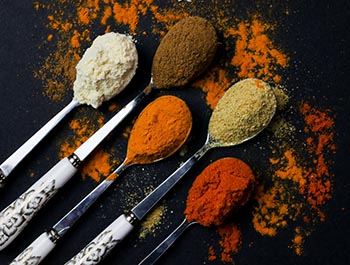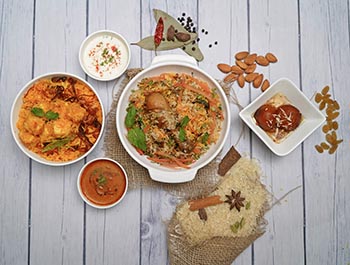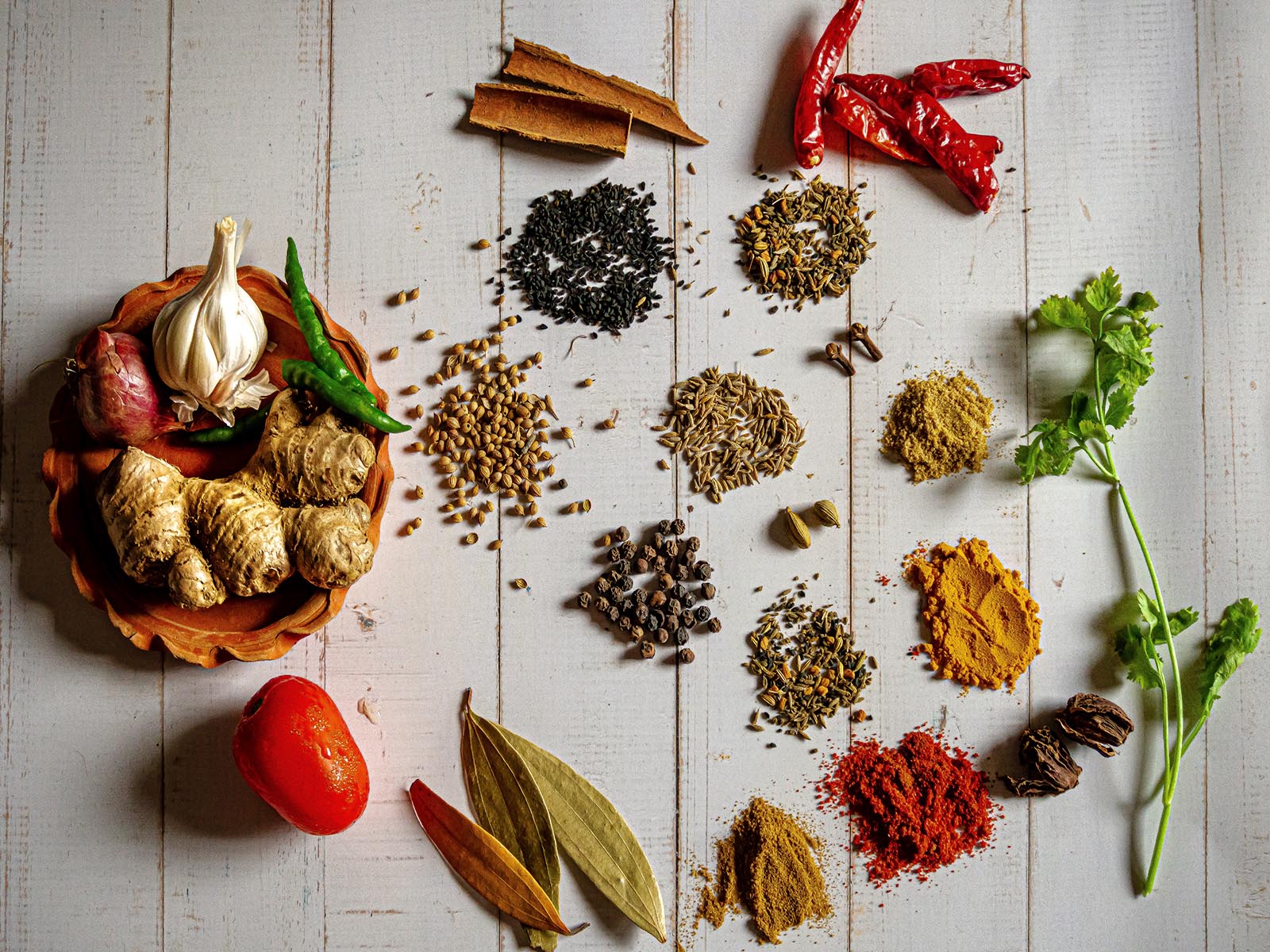There is an endless list of spices, seasonings and flavorings included in the world of recipes for cooking Indian food. If you’re overwhelmed, don’t panic. Check in your cupboard and you probably already have some of the items you will need. For example, look for black peppercorns, bay leaves, chili powder (if you’re already a fan of Chili Con Carne), ground ginger, nutmeg, cloves and cinnamon if you bake cakes or apple pies. Maybe you’ll find mustard seeds if you do your own pickling and sesame seeds if you make rolls or cook Chinese food. That only leaves a few basic ingredients that appear in a lot of Indian recipes — cumin, coriander, turmeric and cardamom. Often you need ground cumin and coriander, but if you buy the whole spices, you can grind them as necessary (and they keep longer that way too).
Consider choosing a fairly simple recipe to start with and just buy the spices you need for that. The next time you want to cook an Indian meal, chose another recipe with similar ingredients so you only have to buy a couple additional items. Soon enough, you’ll build up a whole cupboard of the things you need and it won’t have had such a drastic dent in your budget.
Also, you don’t need special equipment for Indian cookery, just a bit of patience and it’s fun to cook with a friend who can share with the chopping and grinding or read the recipe to you as you go step by step in preparing the dish.
Regional Cuisine Of India: North Indian Flavors
India, one of the most populated nations in the world, has rich and varied culinary traditions, many deeply enmeshed with spiritual traditions that are thousands of years old. Other culinary styles arrived throughout India’s long history with those who wandered into the land from afar and settled here and there, as well as with those who invaded its territories, overtaking native populations. Still others have been shaped by the natural forces climate and geography. These many culinary styles can be generally divided into four regional cuisines, with North Indian flavors and style standing out distinctly from the rest.
The northern part of India, it is said, is part of India in which the influence of the early light-skinned Aryan invaders can still be seen, in the cuisine, culture, and language. This is the part of the world in which Sanskrit is thought to have evolved. North Indian cuisine encompasses the culinary traditions of the various northern countries, including Punjabi, Kashmiri, Awadh, Rajasthani, Marwari, Gharwal and Pahari. Due to climate and growing conditions, wheat plays a stronger role in North Indian cuisine than in other areas of the country. Tandoori cuisine comes from the north.
Spices are an essential element to Indian cuisine, and they use some of the most aromatic and beautiful spices on earth. Historically, however, in addition to serving to add delectable flavors and attractive aromas, the spices were chosen for their food preservation and medicinal properties. While many spices are common throughout most Indian cuisines, the methods and ratios of usage differ in each region, with some spices being much more common in some areas and other flavors being more specific to certain areas. North Indian cooks tend to use their spices in freshly ground powder form.
Chili peppers are common to Indian cuisine, and in the north, the Degchi Mirchi, or Kashmiri chili pepper are especially popular. Ground red chili powder is important North Indian flavor, as is turmeric, cumin, coriander, sweet bay or laurel leaves, black and green cardamom, cassia tree bark, for which cinnamon is often substituted, cloves, nutmeg, saffron, black and yellow mustard seeds, fennel, fenugreek, asafetida, curry leaves, tamarind, and fresh cilantro leaves and mint leaves.
Garam masala is a spice mixture used extensively in North Indian cuisine. This is a blend of spices, which is loosely built upon a set of common spices, but varies widely from region to region, even from family to family. In the north, a basic garam masala would consist of raw cardamom seeds, cinnamon, cloves and black pepper. Ghee, or clarified butter, is particularly important to the flavor of northern cuisine.
Flat breads of various types, including roti, puri, chapattis, different types parantha, and tandoori baked breads, such as nan, are a part of most north Indian meals. Showing the religious influence of the Vaishnava Hindus, the northern states, Uttar Pradesh in particular, have created some of the finest vegetarian cuisine in the world, built upon a wide variety of pulses, or legumes and fragrant Basmati rice.
North Indian flavors have become an important part of international cuisine, spreading throughout the world’s metropolitan centers and into the food cultures of many countries. Beloved especially for its specialized tandoori dishes and vegetarian creations, North Indian cuisine continues to expand and flourish globally.
Regional Cuisine Of India: Tasting East India
 East India, with a complex history that includes long periods of European colonization, has developed culinary traditions that reflect centuries of tradition and a variety of cultural influences. In addition to the various cultures that have been assimilated into the cuisine of the region, the geography also has influenced the development of the culinary traditions of East India, as has the climate.
East India, with a complex history that includes long periods of European colonization, has developed culinary traditions that reflect centuries of tradition and a variety of cultural influences. In addition to the various cultures that have been assimilated into the cuisine of the region, the geography also has influenced the development of the culinary traditions of East India, as has the climate.
Portuguese and Spanish explorers first brought the spices of India to widespread European use in the 15th and 16th centuries, inspiring European political and economic colonization of the area. The famous British East India Company and the Dutch East India Company, both established in the 17th century, were companies specifically created for the production and sale of a variety products from the region, including spices. Naturally, as the native populations interacted with the European peoples, including through forced service in their homes, a European influence came to affect local cuisines.
The coastal area ensures that seafood is an important part of the East Indian diet. The wide variety of fish is served in many ways. Naturally, the area is well known for delectable fish curries, but seafood is also served steamed and delicately spiced, fried with spices that serve to enhance rather than to mask flavors, and is used to created snacks and appetizers like pakora, served with chutneys and other dipping sauces. Because of the prominence of seafood in the cuisine, and a climate conducive to the growth of a variety of vegetables and fruits, as well as the culinary influences of past Portuguese and British colonization and the Muslim population, the food of East India tends to be of a lighter sort. Spices are used with a lighter hand, preferred cooking methods are often of the sort that enhance natural flavors and encourage the subtle blending of flavors, such a stir frying, steaming and boiling. A moist, rainy climate allows for the production of rice, which functions as a basic element of most meals.
In addition to savory fish dishes, East Indian cuisine is known throughout the world for the quality of its sweets, with many of its confections having deep roots in Hindu culture. Many religious ceremonies and celebrations have specific confections associated with them, and include ritual offerings of sweets to gods and to the poor. As with many East Indian dishes, the sweets of this region tend to be less dense, lighter, making them a bit more appealing to westerners than some of the very heavy, ultra-sweet confections of other regions in India. In addition to candies and other similar dessert style sweets, the region is known for its fine cakes, which have a distinctly European influence, as does the preference for tea as a beverage.
East Indian cuisine has a distinct character that sets it apart from the cuisines of other parts of India. With coastal areas that made seafood a staple and a climate that made a variety of fresh foods readily available, came a tendency towards letting the natural, fresh flavors of foods take center stage in the cuisine. European explorers who were attracted to Eastern shores contributed their own culinary style to the region, as did Muslim settlers, resulting in the amazing combination of cultures that created the unique flavors of East Indian cuisine.
Regional Indian Cookery: The Punjab
 The Punjab is situated in eastern India and is divided by the Indian/Pakistani border. It is very fertile because of the rivers that cross here and as a consequence, agriculture is central to the economy. Wheat accounts for a large proportion of the crops, along with corn, mustard greens, sugar cane and rice.
The Punjab is situated in eastern India and is divided by the Indian/Pakistani border. It is very fertile because of the rivers that cross here and as a consequence, agriculture is central to the economy. Wheat accounts for a large proportion of the crops, along with corn, mustard greens, sugar cane and rice.
Buffalo milk which is 3% higher in fat than cows milk, is also important to the Punjabis, who are not prey to worries about cholesterol. Every bit of the buffalo milk is used in some way or other. Some is used in tea or evaporated into a much thicker richer milk known as bhadoli, which in turn is set into yogurt. The thick cream will be removed from the top of the yogurt and churned into butter. Some of the butter will be saved as is and the rest will be warmed slowly and turned into ghee (clarified butter) by pouring off the clear butter and discarding the solid sediment. Yet more of the milk will be made into paneer, the Indian equivalent of cottage cheese. The milk is boiled then curdled by adding lime juice then strained of whey, leaving the curds which can be shaped into solid rounds.
The Punjab is predominantly Sikh, being the home of the Golden Temple at Amritsar, central to the Sikh religion, thus more than half of all Punjabis are vegetarian. No one goes hungry here and Sikh temples always offer simple free meals of bread and vegetable curry to all who turn up.
Bread is the most important part of the Punjabi diet. Rotis are made from wholewheat flour and water, formed into balls and flattened into discs which are then slapped onto the site of a tandoor or onto a tava (a flat griddle pan like a flat frying pan). Rotis are commonly eaten for breakfast with butter, fresh yogurt and pickles, while for lunch or dinner there will be parathas which are much richer, being brushed with ghee, folded and rolled again before being cooked and brushed with more ghee.
Unlike most of the rest of India, rice in the Punjab is for special occasions only or for making rice pudding.
Lunch in the fields will often consist of paratha and a curry made from onions fried with garlic, ginger, green chilis, cayenne, garam masala, tomatoes, turmeric and salt. Potatoes are stirred in and coated with the spices before adding water and cooking slowly.
Breads may also be served for dinner with small black beans and kidney beans cooked with onions, ginger, garlic and tomatoes and garnished with butter. Another favorite is paneer bhaji — tomatoes, chilis and ginger quickly fried with crumbled paneer added — or the same basic mixture with pureéd spinach and cubes of paneer added. Paneer can also be dipped in chick pea flour batter and deep fried, making pakora. Mustard greens may be cooked very slowly with green chilis then when soft, pureéd, thickened with cornmeal flour and added to fried onion, tomato and ginger and garnished with white butter.
For the non-vegetarians, there is tandoori chicken — whole chicken marinaded in yogurt and spices, cut into pieces and cooked in a tandoor — or tikkas (kebabs) of chicken or cubed or minced meat mixed with spices, garlic and ginger.
Cheap fast food restaurants called dhabas are common in the Punjab and often have their own specialties — one may concentrate on paneer bhaji and another, tandoori chicken — but you can be sure that wherever you eat in the Punjab, you will be filled with nourishing, tasty food.
Indian Cookery with a British Twist
There’s no getting away from it, delightful though Indian cuisine is, producing a meal is a complex and time-consuming business, even for the most experienced home cook.
In a traditional Indian home, the wife and mother doesn’t have a job outside the home. She stays at home and spends her days making sure that there is wholesome and tasty food ready for her family to eat whenever they may want it. If there are other older women in the household, such as aunts or a grandmother, they help with the household chores, too.
An Indian girl learning to cook, usually at a very early age, will be expected to help her mother with the household food prep and cleaning, too. At her mother’s side a daughter will learn how to grind spices and mix them to make various masalas and exactly when and how to add them to individual dishes. She’ll learn how to make various types of bread — chapattis, rotis, parathas — and the art of producing the crispest deep-fried onion bhajis and pakora.
That’s the traditional way. However, in modern-day India and Britain, where many Indian families live, life is quite different.
These days, Indian women often don’t have the luxury of staying at home all day. They want or need to go out to work. Indian girls brought up in Britain see other girls their age out shopping, going to parties, visiting with friends, being at school and/or college, and at work and they don’t want to stay at home with their mothers completing household chores or working over a hot stove. Even with all the modernization of cultures, they don’t want to lose the culture and flavors of Indian cuisine.
Indian Tandoori Cooking
Traditionally, tandoori dishes are cooked in a tandoor, an oval shaped clay oven with a small fire in the bottom. The heat rises gradually but ultimately reaches a much higher temperature than a barbeque.
A tandoor is normally used to cook naan bread, meats and kebabs (meat or paneer). The bread is stuck to the sides, the kebabs stood vertically and whole chickens rested on a grid over the fire.
For domestic cooking, a tandoor is not really convenient, but the meat dishes can be reproduced on a barbeque or in the oven. The bright red appearance of tandoori meats which you may see in Indian restaurants is produced by a food dye which really isn’t necessary to enhance the look of your tandoori dishes.
Tandoori style food has flavor without being “hot” or high in calories or too filling. In fact, it’s an ideal dish summer or winter, if you fancy something a little different. As a bonus, it doesn’t take hours to prepare. Of course, you can take all the effort out of it and use a pre-prepared meal, like the delicious Indian meal kits you can pickup here (and get $10 off on your first order PLUS enjoy free shipping on all orders!).
Indian Chicken Tandoori
This quick recipe serves two people. Just multiply it for as many people as you want.
Ingredients:
- 2 Chicken breasts
- 1 small tub Greek yogurt
- 1 tsp ground cumin
- 1 tsp ground coriander
- ½ tsp ground turmeric
- ½ tsp ginger powder
- ½ tsp chili powder (or to taste)
- 1 small clove garlic, crushed
- salt to taste
- 1 tbsp lemon juice
Instructions:
Cut the chicken breasts into 1 inch cubes and set aside.
Mix the spice powders and garlic into the yogurt. You can use low fat yogurt if you prefer. You can also use fresh ginger or ginger paste from a jar rather than ginger powder but go easy on the quantity as it can be quite over-powering.
At this point you can also mix in the salt and lemon juice but if you do so, don’t leave the chicken to marinade for more than about 20 minutes or it will become very dry when cooked. If you want to marinade it for a longer time, add the salt and lemon juice just before you cook the dish or sprinkle on to serve.
Thread the chicken onto skewers and either barbeque or cook under a grill using medium heat until the chicken is slightly browned and cooked through.
For a light meal, serve with salad, pitta or naan bread and lemon wedges or for something more substantial with rice and dahl.
Grab great deals on Indian food delivery and customize your organic Indian groceries and get it delivered to your doorstep
and enjoy Indian food without having to spend time in the kitchen cooking long and complex Indian recipes.
Go for convenience now by ordering a few ready to eat Indian meals — with free delivery — and save time that you can enjoy with your family!


